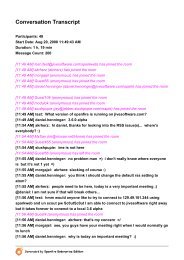Openfire Scalability Enhancements - Ignite Realtime
Openfire Scalability Enhancements - Ignite Realtime
Openfire Scalability Enhancements - Ignite Realtime
Create successful ePaper yourself
Turn your PDF publications into a flip-book with our unique Google optimized e-Paper software.
<strong>Openfire</strong> <strong>Scalability</strong><br />
<strong>Openfire</strong> is a real-time collaboration (RTC) server dual-licensed under the Open Source GPL and commercially. It uses<br />
the only widely adopted open protocol for instant messaging, XMPP (also called Jabber). <strong>Openfire</strong> is easy to set up and<br />
administer, but offers rock-solid security and performance.<br />
This document gives an overview of how the <strong>Openfire</strong> team recently increased the server's scalability by reworking the<br />
server's networking layer as well as by optimizing existing code. The details given here reflect tests on a modest<br />
deployment; for example, connection managers were not used. Tests on a framework that's closer to real-world usage<br />
promise to show even more dramatic improvements.<br />
Summary<br />
In early tests, <strong>Openfire</strong> developers have demonstrated a server scalability improvement from an approximate 6,000-user<br />
maximum in version 3.1.1 to more than 50,000 concurrent users in version 3.2. They achieved these improvements<br />
through enhancements in which they:<br />
Replaced the networking layer with Apache MINA, an open source networking framework that provided support<br />
for asynchronous I/O and a foundation for better scaling. Through MINA, <strong>Openfire</strong> server and connection<br />
managers make more efficient use of threads.<br />
Optimized code to reduce use of performance-expensive APIs and remove unnecessary processing (such as<br />
superfluous user validation and XML parsing).<br />
Implemented a cache to reduce database queries. Administrators can view cache usage data from the <strong>Openfire</strong><br />
admin console.<br />
For business cases that involve extremely high I/O use (such as many group chats, file transfers, and so on), you will<br />
want to use one or more connection managers. For other cases, simply using <strong>Openfire</strong> should meet the need.<br />
Configuration<br />
<strong>Openfire</strong> server was deployed to a machine running Sun 280R Server with two 1.2GHz UltraSPARC-III CPUs, 4GB RAM,<br />
fiberchannel disks, and FastEthernet (100Mbit/s). A MySQL database was used for stored data. An <strong>Openfire</strong> plugin<br />
generated users, populated 40 rosters with 40 contacts in each, and created vCards. Connection managers were not<br />
used; requests were sent directly from simulated users to <strong>Openfire</strong> server. Memory assigned to the Java virtual machine<br />
was 2GB; the server consumed 1GB.<br />
IM tests were run using Tsung, software that simulates users. Tsung was run on a configuration that included two<br />
master machines with three slave machines each. The master machines instructed the slave machines to submit client<br />
requests to the <strong>Openfire</strong> server machine. These requests included logging in 500 - 800 virtual users per second. The<br />
data requests included authenticating, getting the roster, sending chat messages, and getting user vCards.<br />
Two sets of load tests were used: one to log in a large number of users with low levels of activity, and another to<br />
generate a fixed load of 1,500 users who are extremely active and performing resource intensive actions. When one test<br />
was failing to add more users to the system, a second test was launched from two different locations to generate<br />
additional load of 3,000 extremely active users. <strong>Openfire</strong> was easily able to handle the additional load generated by<br />
these users' activities.
Test Results<br />
In tests simulating 300 to more than 50,000 users, CPU usage increased only gradually for <strong>Openfire</strong> server and the<br />
MySQL database used for <strong>Openfire</strong> data.<br />
The following illustration shows performance over a period of seconds. Toward the last third of the test, group chat<br />
testing was activated to increase load. The bottom portion of the chart shows packet reads and writes as the number of<br />
user sessions increases (packet read/writes occur for exchanges of XMPP stanzas such as IM messages, presence<br />
notifications, and information queries). The chart's top portion shows percentage of server CPU use for the same period<br />
of the test.<br />
317 SW Alder, Suite 500, Portland, OR 97204 • Tel: 503 295 3700 • Fax: 503 961 1047<br />
Sales: 877 495 3700 • www.jivesoftware.com • sales@jivesoftware.com














